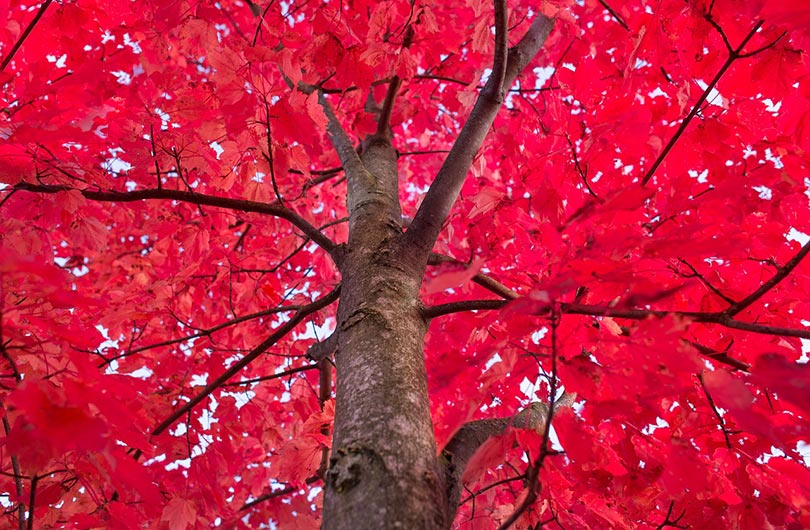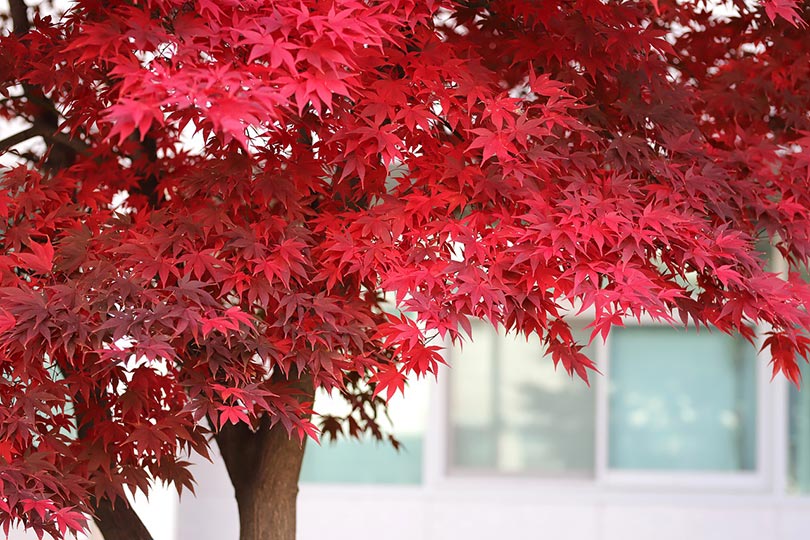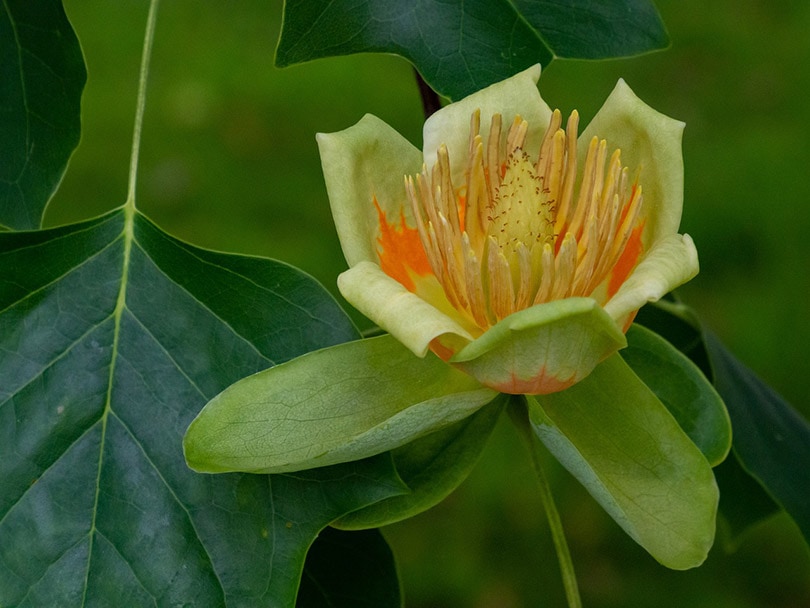17 Fastest Growing Trees: Easy Trees to Grow in Your Yard
-

- Last updated:

Whether you need privacy from the neighbors or some much-needed shade to beat the heat, trees are a cheap way to solve plenty of problems around the property.
The trouble is that with most trees, you have to wait several decades after planting before they mature into usable solutions. At that point, it’s anyone’s guess as to whether they’re going to pay off for you.
If you’re short on time and patience, we’ll show you how to get tall, healthy trees without the wait with this list of 17 fast-growing varieties you can start growing today.
 The 17 Fastest Growing Trees
The 17 Fastest Growing Trees
1. Red Maple

| USDA Hardiness Zone: | 4–9 |
| Full-Grown Size: | 40–60 feet tall, 25–40 feet wide |
| Growth Rate: | 1–3 feet per year |
| Soil Needs: | Moist, acidic |
A tall shade tree that turns vibrant hues of yellow, red, and orange, one Red maple is all you’ll need to add a colorful statement to your backyard. They prefer moist soil and grow taller if given ample space and irrigation for their shallow yet widespread root system.
Different Red maple versions and hybrids offer speedy development and more controlled growth. Sun Valley maple, for example, is a shorter variety that doesn’t produce seeds (“helicopters”) and grows about 2 feet per year until it reaches a full-grown height around 35 feet tall. Autumn blaze, a hybrid of Silver maple and Red maple, grows rapidly, gaining up to 5 feet each year.
2. Dawn Redwood

| USDA Hardiness Zone: | 5–8 |
| Full-Grown Size: | Over 60 feet tall, 15–25 feet wide |
| Growth Rate: | 2–3 feet per year |
| Soil Needs: | Moist, acidic |
The Dawn redwood species survived near-extinction to emerge as a favorite for landscapers looking for massive, fast-growing trees. Although it needs room to thrive and reach heights of over 100 feet tall, dawn redwoods are low-maintenance and tolerant of diverse growing conditions. Its feathery leaves stay green throughout most of the year before turning a coppery color as the months get colder.
3. Leyland Cypress
| USDA Hardiness Zone: | 6–10 |
| Full-Grown Size: | 60–70 feet tall, 15–25 feet wide |
| Growth Rate: | 3–4 feet per year |
| Soil Needs: | Well-draining, pH-neutral |
The Leyland cypress tree is an ideal option as a barrier, with its soft leaves and upturned branches creating a dense windbreak and privacy screen for use along roads or yard edges. It’s a fairly hardy tree, but you can promote rapid growth with good sunlight exposure and well-draining soil. Plant a row of trees spaced about 12 feet apart, and before long, you’ll have a beautiful, neat border of vibrant evergreens.
4. Hybrid Poplar
| USDA Hardiness Zone: | 3–8 |
| Full-Grown Size: | 40–50 feet tall, 30 feet wide |
| Growth Rate: | 5–8 feet per year |
| Soil Needs: | Wet, acidic/alkaline |
Hybrid poplars are a fantastic choice when you need a shade tree fast. It has an impressive growth rate of up to 8 feet per year, giving your home a shady cover in as little as five years.
These poplars require little maintenance and they’re highly tolerant of different soil conditions, periods of drought, and low temperatures. Providing ample shade in the summer with their silvery-green leaves and letting the sunshine through when they shed them in the winter, a well-placed line of poplars can be a huge help in maintaining year-round comfort in the house.
5. Crape Myrtle

| USDA Hardiness Zone: | 6–10 |
| Full-Grown Size: | 15–35 feet tall, 10–15 feet wide |
| Growth Rate: | 2 feet per year |
| Soil Needs: | Moist, well-draining, acidic |
Crape myrtles are some of the most beautiful and fast-growing additions to your yard as a privacy screen or a brilliant shade provider. With over 50 varieties, you can select from a wide array of pink, red, white, and purple hues, as well as heights ranging from under 1 foot to over 35 feet tall. Give them plenty of sun and well-draining soil, and you’ll have resilient growth to give you gorgeous displays season after season.
6. River Birch
| USDA Hardiness Zone: | 4–9 |
| Full-Grown Size: | 50–60 feet tall, 40 feet wide |
| Growth Rate: | 2 feet per year |
| Soil Needs: | Moist, acidic |
Its shimmery gold autumn foliage is a major highlight, but the main attraction of river birch is its peeling, papery brown bark. Add some unique texture to your garden or pond edge with this water-loving shade tree, which is not only easy to grow but also a great way to attract colorful wildlife to the yard. It boasts a stronger resistance to disease than other birch varieties, and its seeds and branches offer food and shelter to birds.
7. Quaking Aspen
| USDA Hardiness Zone: | 1–7 |
| Full-Grown Size: | 25–60 feet tall, 20–30 feet wide |
| Growth Rate: | 2 feet per year |
| Soil Needs: | Moist, well-draining, acidic |
From a lustrous bright bark reminiscent of paper birch to its luminous gold leaves in the fall, quaking aspens are some of the most attractive candidates to spruce up your yard in a hurry. In a light breeze, the leaves create a shimmering dance that brings movement and ambiance to the yard, unlike any other tree. Although they don’t grow as fast as some of the other trees on this list, you won’t have any complaints once you realize the difference they can make for your landscaping.
8. Pin Oak

| USDA Hardiness Zone: | 4–8 |
| Full-Grown Size: | 40–60 feet tall, 40 feet wide |
| Growth Rate: | 2–3 feet per year |
| Soil Needs: | Moist, well-draining, acidic |
If you want a dense cover of leaves and a dramatic transformation of color, look no further than the pin oak. The dark green leaves turn an orange-red tone as the seasons change, with trees sporting a rich color deep into fall and winter.
Despite its thin profile and shallow root system, the pin oak creates a sturdy, thick pyramid of leaves to shade a lawn. In ideal conditions with plenty of sun and moist, slightly acidic soil, a pin oak can grow up to 100 feet tall.
9. Paper Birch
| USDA Hardiness Zone: | 2–7 |
| Full-Grown Size: | 60 feet tall, 35 feet wide |
| Growth Rate: | 2 feet per year |
| Soil Needs: | Moist, well-draining, acidic |
Unlike the tannish-brown skin of the river birch, the bark of paper birch is more of a pure white that peels back to reveal orange inner layers. The leaves are no less striking, turning a crisp gold color in the fall. Paper birch trees don’t live long when cultivated, usually maxing out around 30–40 years, but their pest resistance, general soil tolerance, and fast growth rate make them an excellent choice for an exciting landscaping addition.
10. Tulip Tree

| USDA Hardiness Zone: | 4–9 |
| Full-Grown Size: | 80–100+ feet tall, 50 feet wide |
| Growth Rate: | 2–3 feet per year |
| Soil Needs: | Rich, moist, well-draining, acidic |
Tulip trees, also called tulip poplars, are some of the most impressive of the fast-growing trees, so make sure you give them plenty of space to expand. It’s the tallest eastern hardwood, with many trees eclipsing 120 feet in height. With pretty yellow-green blossoms arriving in late spring, it’s no wonder the tulip poplar is the state tree for not one but three states– Indiana, Kentucky, and Tennessee.
11. Green Giant Arborvitae
| USDA Hardiness Zone: | 5–7 |
| Full-Grown Size: | 50–60 feet tall, 15 feet wide |
| Growth Rate: | 3–5 feet per year |
| Soil Needs: | Well-draining, loamy |
With a bushy density, tall yet slender frame, and lightning-quick growth rate, the Green Giant arborvitae was seemingly made to be a privacy screen. The hardy tree grows up to 5 feet per year, giving you a sturdy windbreak and noise barrier in the blink of an eye.
Green Giants can get rather tall, reaching heights over 60 feet so they may need a little room to grow. For a smaller and potentially more practical alternative, you can try their shorter cousin, the emerald green arborvitae, which maxes out around 12 feet. Both varieties tolerate a variety of soils and resist pests, making them a low-maintenance substitute for more expensive hedges and fences.
12. Eastern White Pine

| USDA Hardiness Zone: | 3–7 |
| Full-Grown Size: | 50–80 feet tall, 20–40 feet wide |
| Growth Rate: | 2–3 feet per year |
| Soil Needs: | Moist, well-draining, acidic |
Eastern white pines hit you with rapid initial growth before slowing down after a few years, but it’s enough to get you a workable privacy screen and windbreak in no time. The misnamed evergreen delights and protects with a thick bush of long, soft blue-green needles. Grow some eastern white pines for a privacy screen and add a few off to the side for a convenient Christmas tree supply!
13. Sargent Cherry
| USDA Hardiness Zone: | 4–7 |
| Full-Grown Size: | 25–50 feet tall, 25–50 feet wide |
| Growth Rate: | 2 feet per year |
| Soil Needs: | Rich, moist, well-draining, acidic |
If you want a stunning centerpiece for your yard, the Sargent cherry deserves your attention. The fast-growing flowering tree provides a mesmerizing transition of color throughout the year. Late spring pink blooms set the stage for lush green leaves that turn into powerful red and orange hues in the fall. All the while, lustrous red-brown bark creates an attractive accent complementing the floral display and offering an enduring colorful foundation through the winter.
14. Japanese Zelkova
| USDA Hardiness Zone: | 5–8 |
| Full-Grown Size: | 50–80 feet tall, 50–70 feet wide |
| Growth Rate: | 2 feet per year |
| Soil Needs: | Moist, well-draining, acidic/neutral |
Growing up to 80 feet tall with a nearly equal girth, a single Japanese zelkova can provide your property with all the shade it needs. It’s easy to grow, resisting pests, drought, and disease while also tolerating most soil types, as long as it’s well-draining. These hardy plants are long-lasting and durable in all kinds of growing conditions, a bountiful shade tree for both rural and urban settings.
15. Chinese Pistache

| USDA Hardiness Zone: | 6–9 |
| Full-Grown Size: | 25–35 feet tall, 25–35 feet wide |
| Growth Rate: | 2 feet per year |
| Soil Needs: | Moist, well-draining |
When you give it enough sunlight, the Chinese pistache takes on an alluring round shape, obtaining a pure symmetry with little intervention. The dark green leaves are subtle during the summer, but in the fall, they transition into long feathery displays of rich reds, oranges, and yellows. Ideal for warmer regions, the pistache stays strong through intense heat and periods of drought as long as you give it fertile soil and ample sun to grow.
16. Eastern Redbud

| USDA Hardiness Zone: | 4–9 |
| Full-Grown Size: | 20–30 feet tall, 25–35 feet wide |
| Growth Rate: | 2 feet per year |
| Soil Needs: | Rich, moist, well-drained |
There’s no need to wait on a blooming show of colors when you plant the eastern redbud. Flowers of pink and magenta arrive in early spring, preceding reddish leaves that transition to green and finally yellow in the fall. Growing further out than up, the eastern redbud is a pleasant shade tree that you can grow in partial sunlight and a variety of soil types.
17. Sweet Bay Magnolia
| USDA Hardiness Zone: | 5–9 |
| Full-Grown Size: | 10–20 feet tall, 10–20 feet wide |
| Growth Rate: | 2 feet per year |
| Soil Needs: | Moist, well-drained, acidic |
Growing over 2 feet per year in perfect conditions, it doesn’t take long for Sweet Bay Magnolia trees to reach their max height of up to 20 feet. When they do mature, their shining silver-green foliage and creamy flowers provide an all-around sensory delight, with glistening white blooms offering the yard a sweet, lemony aroma in late spring. You may even enjoy the arrival of various birds in early fall thanks to its bright red fruit.
Conclusion
It’s surprising how simple it is to add a full-grown tree to your property, and you can do it without sacrificing sturdiness or longevity. Choose trees that thrive in your hardiness zone and soil conditions to get the tallest and fastest growth. With any of these quick-growing options, you’ll provide a gorgeous statement for your landscaping with minimal effort and even less waiting around.
Featured Image Credit: Skitterphoto, Pixabay
Contents
 The 17 Fastest Growing Trees
The 17 Fastest Growing Trees
